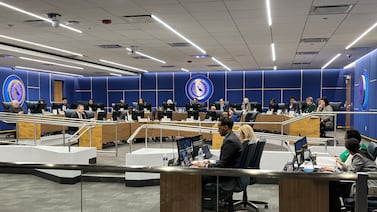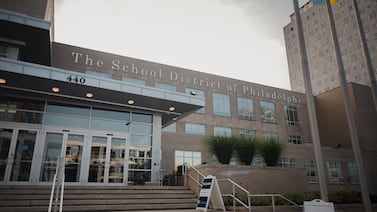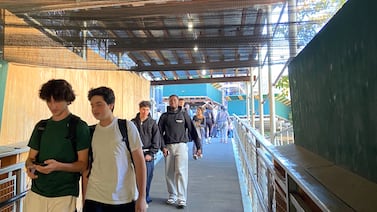Sign up for Chalkbeat Newark’s free newsletter to keep up with the city’s public school system.
A multimillion dollar project to install AI cameras in Newark Public Schools is delayed due to extensive lead stabilization and asbestos abatement that needs to be completed on the city’s aging schools, Chalkbeat has learned.
The district had planned to upgrade its surveillance systems by the start of the school year using federal American Rescue Plan funds, which are set to expire Sept. 30. But the project to install roughly 7,000 AI cameras across all schools is being delayed so the remediation work can be completed as the project progresses, according to a request for a federal extension obtained by Chalkbeat. District leaders also cited delays with vendors who required certified and qualified staff to complete the work and issues in getting buildings empty.
Newark’s school buildings are among the oldest in the state and many have been crumbling for decades. State officials have been slow to address the needs but in 2019, gave Newark $3.9 million to cover asbestos removal from school buildings, the same year data showed elevated levels of lead were found in seven district schools.
When asbestos fibers are inhaled, they could get trapped in the lungs and over time, cause scarring and inflammation that affect breathing and may lead to cancer, the National Cancer Institute says. Similarly, exposure to lead can result in problems such as anemia, kidney and brain damage, and learning disabilities and developmental problems in children, according to the Centers for Disease Control and Prevention. Despite cleanup over the years, many district buildings continue to require asbestos abatement, lead stabilization, and structural upgrades among other needs.
Newark Public Schools did not respond to questions about asbestos and lead remediation in schools.
The U.S Department of Education has encouraged school districts to spend their COVID relief funds before the deadline this fall but has allowed districts to request an additional 14 months to close out and finalize construction projects, programs, or other work funded by American Rescue Plan dollars, the final and largest of three relief packages approved by Congress. Districts have to explain why they need the extra time and requests to extend funds must be tied to existing contracts for school projects or purchases.
The work to install Newark’s cameras and connect the required cabling districtwide is projected to cost $17.5 million with funding coming from $2.3 million in local funds and the rest through American Rescue Plan dollars, according to the district. Newark has said it needs to update its outdated surveillance system to make schools safer and allow for 24/7 monitoring following two shootings outside schools that left three students injured last school year.
Like many districts, Newark school officials have had to rethink their needs as they face the end of the one-time funding. They no longer require plexiglass shields and masks used at the height of the pandemic but other needs remain.
But it’s too early to gauge the impacts of school districts’ use of relief funds, said Julia Martin, director of policy and government affairs for the Bruman Group, a Washington law firm focused on education.
“School districts are reluctant to spend the money on short-term items because they know they won’t last, and it’s hard for them to spend the money on things like staffing, because when the money runs out, then you have to let that person go,” Martin said.
In total, Newark received $287 million in federal COVID relief funds, less than a quarter of Newark’s $1.5 billion budget this school year. That money was distributed through three relief packages meant to help districts reopen schools and recover from the pandemic. Half of the district’s American Rescue Plan dollars was slated for facilities projects to update its aging buildings, a problem about which school officials have been sounding the alarm for years.
During the pandemic, district leaders were concerned about updating Newark’s ventilation systems in schools to prevent the spread of COVID in classrooms. Although those concerns aren’t as prevalent, Martin says school districts are still focusing on improvements to their buildings to mitigate the long-term effects of the pandemic. In one district, officials used federal funds to fix leaky roofs where mold was growing, a factor that could have exacerbated asthma among students, Martin said. Another school district used COVID funds to renovate its bathrooms after noticing an uptick in students smashing mirrors and fighting in bathrooms post-pandemic, Martin said.
In Newark, district leaders are also faced with helping nearly 40,000 students recover from the negative effects of the pandemic. New Jersey’s youth has faced an unprecedented mental health crisis, a trend on par with students nationally as many struggle with anxiety and depression at levels higher than those pre-pandemic. Last school year, district state test scores went up by 2 percentage points in math and English language arts while only 19% of third graders passed the English assessment, the lowest of any grade in the city for a second year in a row. The challenges point to the ongoing need to help students recover academically from pandemic-era learning disruptions.
“If you just cared about the future of the district, you might say these facilities are going to be around for a long time,” said Marguerite Roza, director of the Edunomics Lab at Georgetown University. “But if you care about the future of the kids that suffered during the pandemic, they’re going to walk out the door with permanent impacts that will never get addressed.”
Newark’s request to extend the funds for its AI camera project was approved in July, allowing the district to cash out almost $17 million by March 2026, roughly 9% of Newark’s $182 million in American Rescue Plan funding. Of that money, roughly $13 million is being used to pay for two vendors to install the AI cameras and respective cabling work, according to purchase orders included in Newark’s request to the state. Another $4 million is tied to expenses for school upgrades, paint jobs, and new furniture that were on back order or delayed due to environmental issues “beyond the district’s control,” according to Newark’s June application to the state.
“How does this decision fit into this bigger agenda to get kids back on track after the pandemic? Because they fell a lot in the pandemic,” said Roza, about the school district’s use of federal COVID relief funds.
The district has used previous COVID relief funds to help pay for items such as air conditioners, Smart Boards, internet access, mental health programs, and professional development for teachers among other things. It also helped expand summer and tutoring programs, which Superintendent Roger León has previously said were the district’s “saving grace” in helping students move forward academically.
According to a national survey by the School Superintendents Association, adding instructional time and addressing mental health needs were the top two priorities for districts across the country followed by purchasing technology and providing students with internet access. The fourth and most common priority was investing in high-dosage tutoring and professional development followed by renovating school facilities to improve learning, air quality, and overall conditions of learning.
Jessie Gómez is a reporter for Chalkbeat Newark, covering public education in the city. Contact Jessie at jgomez@chalkbeat.org.





